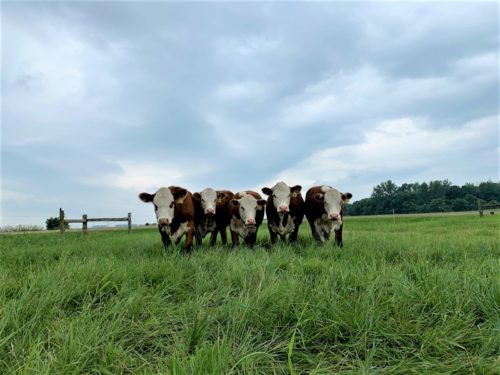Humidity, Wet Pastures, and Foot Rot
Posted: July 18, 2019 | Written By: Kristi Carpenter, M.S., Form-A-Feed Nutritionist

Summer has officially arrived but “Spring Showers” continue to inundate the mid to southwest regions of the United States. Saturated pastures coupled with humid conditions bring on the threat of lameness and producers need to be on the look-out.
Lameness is the first sign of foot rot, a highly infectious and sub-acute disease affecting cattle of all ages. Fusobacterium necrophorum is the bacterium most commonly isolated in foot rot diagnoses but can work in cooperation with other bacterial agents (Prevotella melaninogenicus and Porphyromonas levii)1. Entrance points caused by puncture wounds, abrasive surfaces or continuous exposure to wet and muddy conditions can cause lesions which allow for bacteria to enter the tissue of the foot. High temperatures and humidity can lead to chapped and cracked skin- damaging interdigital skin health. As we experience high temperatures and humid conditions this summer, cattle will be gravitating toward ponds, water stations or other standing water sources to stay cool.
Clinical signs of foot rot include2:
- sudden lameness, commonly in a single foot (severity will increase over time)
- swelling and redness around both digits and hairline of the hoof
- interdigital lesions that result in a foul odor and separation of the claws
- fever
- decreased intake
Other foot conditions that commonly result in lameness typically involve a single claw, whereas swelling attributable to foot rot includes both digits of the hoof. When diagnosing foot rot, a thorough examination is necessary in order to ensure a proper treatment plan. When detected and treated in the early stages of infection, chances of a successful recovery are high. However, delaying treatment can result in poor weight gains, increased costs and unwarranted stress on the animal. A local large-animal veterinarian will be able to provide the most appropriate information regards to commercial vaccines and antibiotic protocols.
PREVENTION
Environmental management is key for foot rot prevention. If foreign objects and debris can be eliminated from the environment, then the chances of tissue damage to the foot decreases. Pen conditions should be monitored and scraped. Areas around water tanks or standing water should be managed to reduce the amount of time standing in mud and manure. A footbath protocol should be implemented and properly mixed according to directions (refresh regularly).
A well- balanced mineral program can also aid foot health. Adequate dietary zinc is necessary for maintaining skin and hoof health. Studies show that zinc methionine supplementation improved gains and decreased the incidence of foot rot in pasture grazed steers3. Supplemental iodine in the form of EDDI (ethylenediamine dihydroiodide) has been shown to prevent naturally occurring foot rot in beef cattle4. Other important nutrients that should be reviewed in a vitamin-trace mineral program include copper, selenium and biotin.
SUMMARY
Healthy skin will prevent bacteria from entering the body, but compromised tissue can open the door to infection. A thorough examination of the foot is necessary to distinguish foot rot from other diseases; proper diagnosis will result in a proper treatment plan. Monitoring pasture conditions for hoof-health risks, feeding a well-balanced nutrition program, and early detection of lameness will help protect your herd this summer. Contact your Form-A-Feed representative today to see how they can best assist you!
- Maas, J. “Preventing and treating foot rot in cattle (Proceedings)” 1 Aug, 2009. http://veterinarycalendar.dvm360.com/preventing-and-treating-foot-rot-cattle-proceedings. Accessed 12 July, 2019.
- Currin, JF, Whittier, WD, Currin, N. “Foot Rot in Beef Cattle” 2009. https://www.pubs.ext.vt.edu/content/dam/pubs_ext_vt_edu/400/400-310/400-310_pdf.pdf. Accessed 9 July 2019.
- Maas, J, Davis, LE, Hempstead, C, Berg, JN, and Hoffman, KA. Efficacy of ethylenediamine dihydroiodide (EDDI) in the prevention of naturally-occurring foot rot in cattle. Am J Vet Res, 45:2347-2350, 1984.
- Brazzle, FK, Lusby, KS, Simms, RH. The Effect of Zinc Methionine in a Mineral Mixture on Gain and Incidence of Foot rot in Steers Grazing Native Grass Pastures11Contribution No. 95-73-E from the Kansas Agricultural Experiment Station. The Professional Animal Scientist, 10:169-171, 1994.